Want to just get started? Click here to sign up for Hostinger and start your blog.
This blog generates hundreds of thousands of dollars every month by helping readers answer their questions.
It took years to get to this point—but you can start a profitable blog right now.
The money is there if you keep at it and follow some tried and true methods like the ones below.
11 Steps to Start a Blog That Makes Money
Turning a profit requires a few more steps than hobby blogging (doing it just for fun and not worrying about consistency, SEO, and monetization). Here are the steps you need to know about how to start a blog:
- Find a blog idea
- Find the perfect domain name
- Sign up for Hostinger
- Install WordPress
- Pick a fitting WordPress theme
- Install WordPress plugins
- Install Google Analytics
- Set up your email list
- Pick a blogging cadence
- Build an audience
- Monetize your blog
Quickstart Guide to Blogging
You can jump straight into blogging if you already have a name and an idea for your blog.
Just head over to Hostinger and sign up for the Premium plan with the QuickSprout discount for $2.79 per month for 12 months. Hostinger is the best hosting service for most people and the easiest way to start a new blog.
The Premium plan normally starts at just $2.99 per month. This rate is based on a 48-month contract, and it’s a great deal if you want reliable service from a reputable provider for the long haul. In addition to web hosting, you’ll get a free domain name, website builder, unlimited free SSL certificates, designer-crafted templates to choose from, and everything else you need to get started.
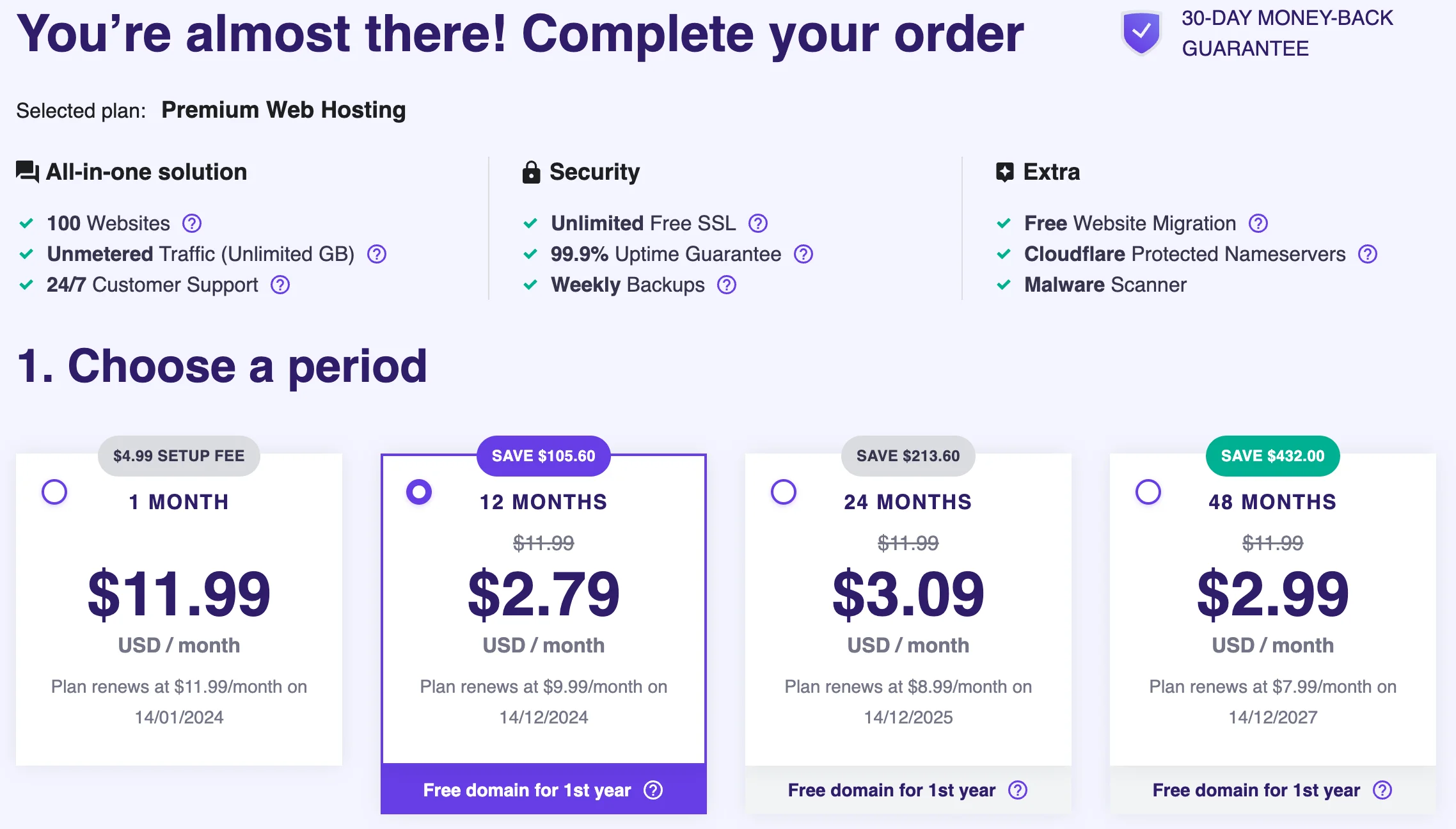
The registration process is simple. Hostinger will walk you through a series of steps that are very straightforward. Here’s a quick overview that you can follow:
- Go to Hostinger and select the web hosting option.
- Purchase the plan and log into Hostinger.
- Claim your free domain in the account dashboard (or you can skip this and claim it later).
- Click Setup in the account dashboard and follow the prompts.
- Choose Create a new website since you aren’t migrating an old site.
- Select WordPress as your CMS and Hostinger will install it automatically with one click.
- Choose a theme to determine your site layout. You can always change this later, so don’t overthink it.
- Choose if you want to keep any of the recommended plugins that are offered.
- Since Hostinger gives you a free domain with your plan, you can claim your domain at this step (if you did this earlier, your domain name will appear and you can select it).
- Complete the setup once you’ve reviewed and confirmed the selected options.
Now you can log into your new website and start blogging immediately.
Monetizing your blog is the next step. There are lots of different ways to make money from your blog, and we’ll cover that later on. For now, let’s dive straight into the entire blog creation process from the beginning.
Step 1: Find a Blog Idea
This is the most important step for your blog.
Choosing your blog’s topic (or niche) determines the rest of the website’s future. This is what you’re going to be writing about and—hopefully—making money from.
The good news: There’s practically an audience out there for every single topic you might be interested in.
But some topics tend to perform better than others. You need to find a topic that appeals to a big audience while still appealing to you.
To find the perfect blog niche, you’ll need to answer two questions:
What are you interested in?
What topic do you love? What are you obsessed with?
This is the basis of your blog niche. After all, if you don’t love the topic, you’re not going to want to write about it day after day.
Here’s some inspiration to help you answer this question:
- Talents. Is there something you’re naturally talented at? Maybe a sport, game, or musical instrument.
- Expertise. What skills and knowledge have you built up over the years? Maybe there’s something you went to school for that you can write about now. Think about academic subjects or skills like languages and car repair. Even having a wealth of lifestyle knowledge can be shared.
- Career. Your current career can be a fantastic place to write about. For example, if you’re a developer for a startup, you can start blogging about front-end development or the tech industry. Likewise, if you’re an experienced photographer.
- Hobbies and passions. Is there a topic you just love learning about? Think about the things you do in your free time. Maybe it’s reading books, working on your fantasy novel, or repairing that old car in your garage. These can be great topics to write about in your blog.
ACTION STEP: Write down 10-15 topics you’re interested in. Pull up a blank document or sheet of paper and write this down. It’ll help you keep your ideas focused. Plus, you can refer back to it later when you make your final decision.
What are other people interested in?
This area is a bit trickier.
You need to find out what other people are interested in as well. Otherwise, you might find yourself with a blog that doesn’t draw in a lot of people.
For example, you might think that a blog all about how wonderful your dog is is super interesting—but is that going to draw in a lot of people?
On the other hand, a blog about how to take care of and train dogs appeals to a much bigger audience of readers.
You need to take your personal interest and find a way to make it universal. Think back to how you initially gained interest in the topic. How did you gather expertise in the topic?
Think of all the questions and confusions you had when you started out and what helped you gain expertise.
To help, here are a few popular categories that always do well:
- Personal finance
- Fitness
- Online business
- Investing
- Productivity
- Real estate
- Careers
- Test prep
- Freelancing
Pro tip: Use Google’s Keyword Planner tool to see how often people search for a specific category or niche. It’ll reveal what people are and aren’t interested in.
ACTION STEP: Take a look at your list from before. Do any of them fall under these categories? If not, that’s okay! There’s probably still an audience out there for one of your topics.
For now, choose a topic from your list that you want to turn into a blog. Once you do, you’re going to make it even more specific and niche it down.
For example, you might want to start a personal finance website. Niching it down might mean you make a personal finance website for millennials making $100,000 a year. Or for 30-somethings who want to retire early.
Look back at the different topics you generated in Step 1. Can you blend two topics you like writing about to hone in on a niche?
Step 2: Find the Perfect Domain Name
Now the fun part: choosing your blog’s name. Fair warning, there’s good news and bad news for this step.
- Bad news: Most of the very “best” domain names are already taken. The internet is decades old. Makes sense.
- Good news: That doesn’t matter because we’re going to find the best one for you.
Here are a few good rules of thumb to keep in mind when choosing a good name:
- Keep it short. Don’t force potential visitors to have to type a bunch of words to visit your website. We recommend no more than 14 characters.
- Choose a .com, .org, or .net. These are the easiest ones for people to remember.
- Easy to spell and pronounce. You don’t want to spell it out constantly for people when you mention your blog’s domain.
- Avoid numbers and hyphens. Not only does it look clunky in the URL, it’s also difficult to type out when you add hyphens.
- Use your name. It’s pretty likely that your name is available as a domain. That makes it the perfect choice for a personal blog.
When you come up with a domain you like, head to Hostinger to see if it’s available.
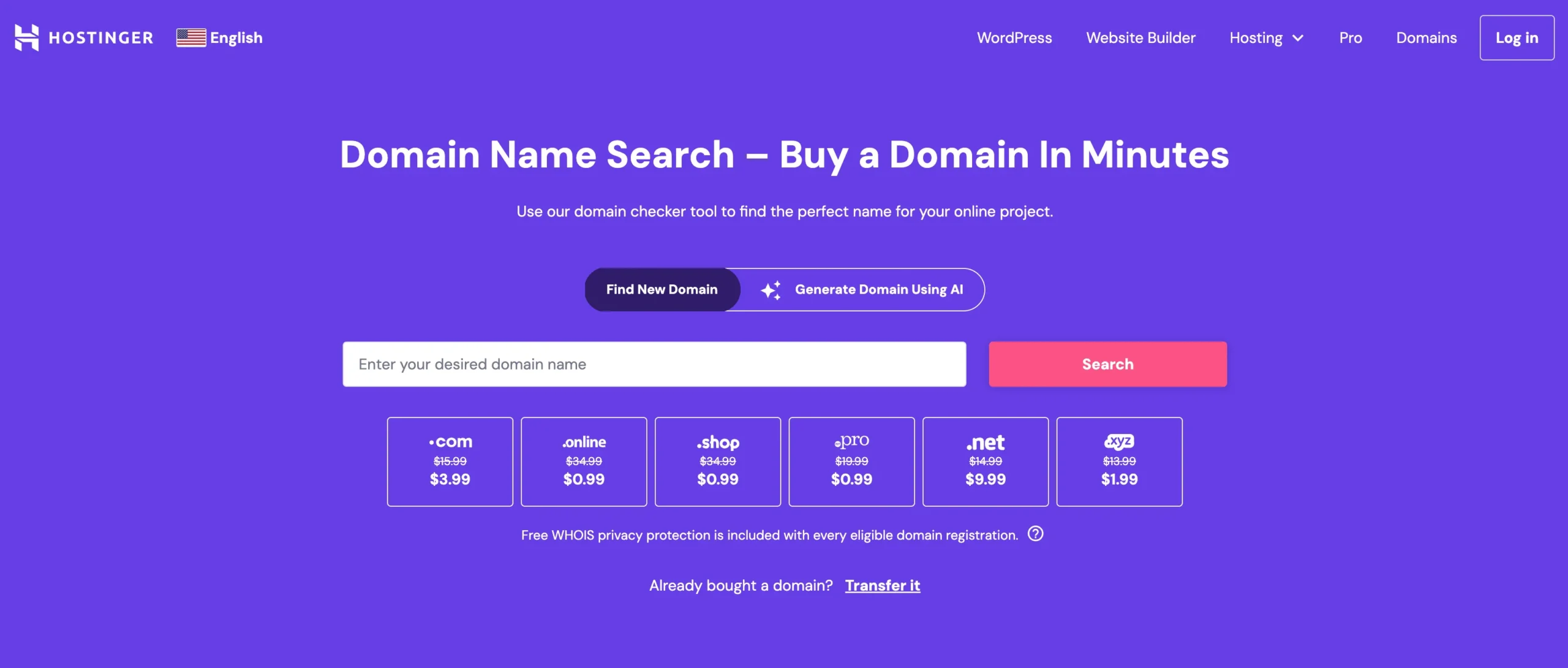
If it is, great! If not, you now have three options:
- Search until you find an available domain. We highly recommend you do this until you find a domain that’s available. If you’re going to write a blog, sharpen your synonym skills by searching for other words and phrases that might be available.
- Purchase a domain name. While it is possible to buy a domain from someone who already has it, that’s an advanced option and can get expensive fast. Low-quality domains will usually go for a few thousand dollars. Highly quality domains that are two words can easily go for $10,000 to $50,000. Not to mention all the hassle that comes from finding the person who owns the domain, negotiating with them, and transferring the domain if you even reach an agreement.
- Use an AI name generator. If you’re having trouble coming up with a unique blog name on your own, you can enter keywords related to your niche into an AI name generator. Luckily, Hostinger has one on its domain-search page that you can use for free.
Your best bet is to keep going until you find a domain that you like and can purchase directly from a domain registrar for about $10.
We go into lots of detail on which domain registrar to use here. But we highly suggest you use a web host that allows you to register a domain for free. That means going with Hostinger.
Using your personal name as the domain
If this is your first blog and you’re not completely sure what you want to blog about, you can always use your personal name.
The reason is that changing your domain later will mean that you have to start over from scratch. There are a lot of mistakes in blogging that can be corrected later; having the wrong domain isn’t one of them.
Let’s say you pick a domain like fitnessfordoctors.com. Then after six months, you realize you’d rather be doing personal finance blogging for doctors. You’d need to get a new domain and start over from scratch.
Personal domains are much more flexible—it’s just a name after all. So if you jump categories after a few months, it’s not a big deal. Take down any old content that’s not relevant to your new direction, start posting new content, and you’re good to go.
That said, personal domains have two major downsides:
- Scalability. It’s much more difficult to recruit other writers or grow your blog beyond your personal identity later on.
- Profitability. Personal blogs, even if they’re generating serious cash, are much harder to sell. Prospective buyers want a site that isn’t dependent on a single person.
However, these are pretty advanced problems to have. If this is your first blog, the benefits of using your name as the domain greatly outweigh the costs that only show up down the road.
ACTION STEP: Pick a domain name and run with it.
While it’s important to pick a good, brandable domain name, the most important thing to do in this step is to make a decision and go. You don’t want to be stuck in the dreaded state of “paralysis by analysis.” Instead, just choose one based on the system above and run with it.
Go deeper: Want to learn more about this topic? Check out our article on how to buy the right domain name.
Step 3: Sign Up For Hostinger
Every website needs to have a web hosting provider. Your web host runs the servers where your site will “live” on the internet—making it possible for people to visit your blog.
This is one of the most important steps in this process, so don’t rush through it.
Having a quality web host ensures that your site loads quickly, performs well, and doesn’t crash unexpectedly.
You can check out our complete list of the best web hosts for WordPress, but Hostinger will be the best option for most new blogs—and that’s what we’ll use for the purposes of this tutorial.
Hostinger is straightforward and affordable, which is exactly what new blogs should be looking for in a web host.
For such an affordable price, Hostinger also performs at a really high level. So you’re still getting a high-quality hosting service at an entry-level price tag.
Speaking of price, you can get Hostinger’s Premium shared hosting plan for just $2.79 per month with a 12-month contract when you sign up using our special discount link. This is an amazing value when you consider all the features you’re getting.
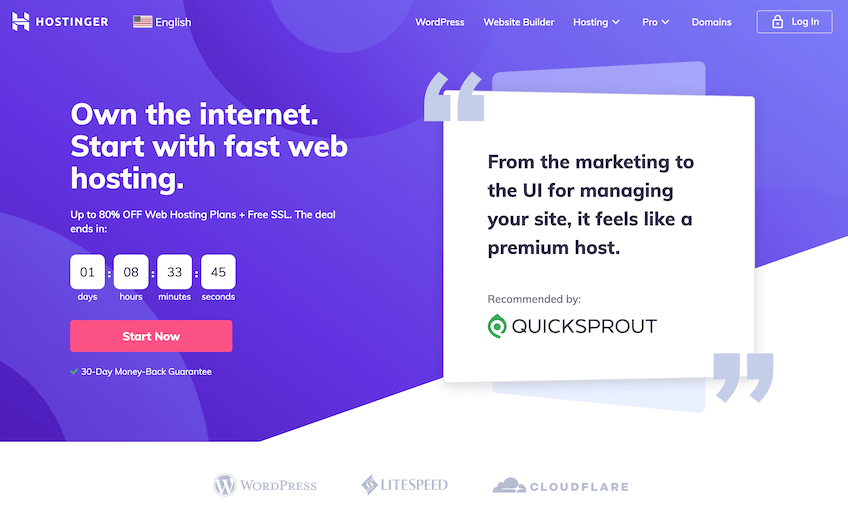
The great part about Hostinger is that it can grow with you as your blog scales. So as you start getting more traffic over time, you can simply upgrade your plan to the next tier as needed.
If you’re looking for a simple and reliable web hosting service, look no further than Hostinger. Plans are backed by a 30-day money-back guarantee.
Step 4: Install WordPress
Your website needs a content management system (CMS) in order to function. This CMS is what allows you to create and manage blog posts.
And for this, there’s only one option: WordPress.
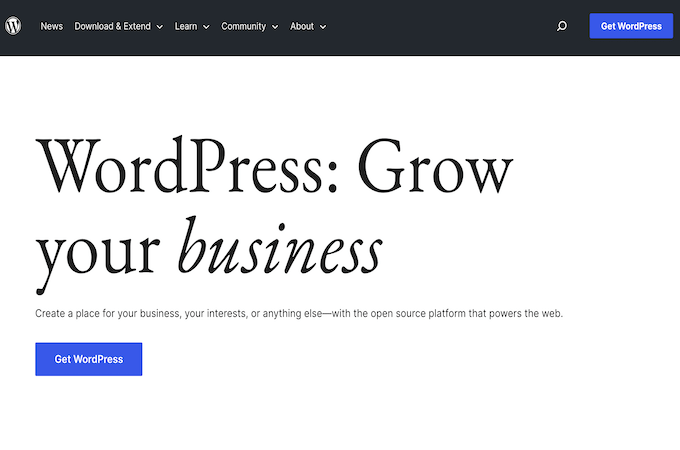
In reality, there are far more options than just WordPress, but trust it’s the only one you should use.
Why?
Because WordPress is one of the (if not the) most powerful, easy-to-use, and customizable CMS platforms out there.
Here’s proof: WordPress powers roughly one-third of the internet. Pause on that for a moment–one-third of the entire internet. That’s a lot.
Since WordPress is one of the most popular CMS platforms in existence, most web hosts offer a one-click install for WordPress making the setup a quick and painless experience.
There’s always the option to use a dedicated blogging platform like Medium or even LinkedIn. Both are great for sharing ideas, but they are quite difficult to generate any revenue from. WordPress, on the other hand, gives you plenty of ways to turn a profit, which is why it’s one of the most popular choices.
So, if you’re trying to make money blogging, WordPress is definitely the better choice.
ACTION STEP: Install WordPress on your host.
Hostinger makes it super easy to install WordPress. In fact, they offer WordPress-specific hosting plans that come with one-click WordPress installation.
And here’s a secret. The WordPress plans cost exactly the same as Hostinger’s regular shared hosting plans.
So if you’re planning to host with Hostinger and blog with WordPress (both of which we recommend), then signing up for a WordPress hosting plan is a no-brainer. Hostinger even provides automatic WordPress updates to ensure you’re always on the latest and most secure version.
Step 5: Pick a Fitting WordPress Theme
It’s very easy to change your site’s look and feel with WordPress.
The best part: No coding knowledge is required.
That’s because WordPress uses “themes.” These are little packages of code that can be swapped in and out. Whenever you change your theme, your site will also change, but your blog content stays the same.
This makes it very easy to evolve your site over time without having to rebuild your entire site from scratch.
Hostinger offers a bunch of free and customizable WordPress themes for you to get started. Choose something that you like, but don’t get too precious about it at this point. You can switch up your theme later with very little work.
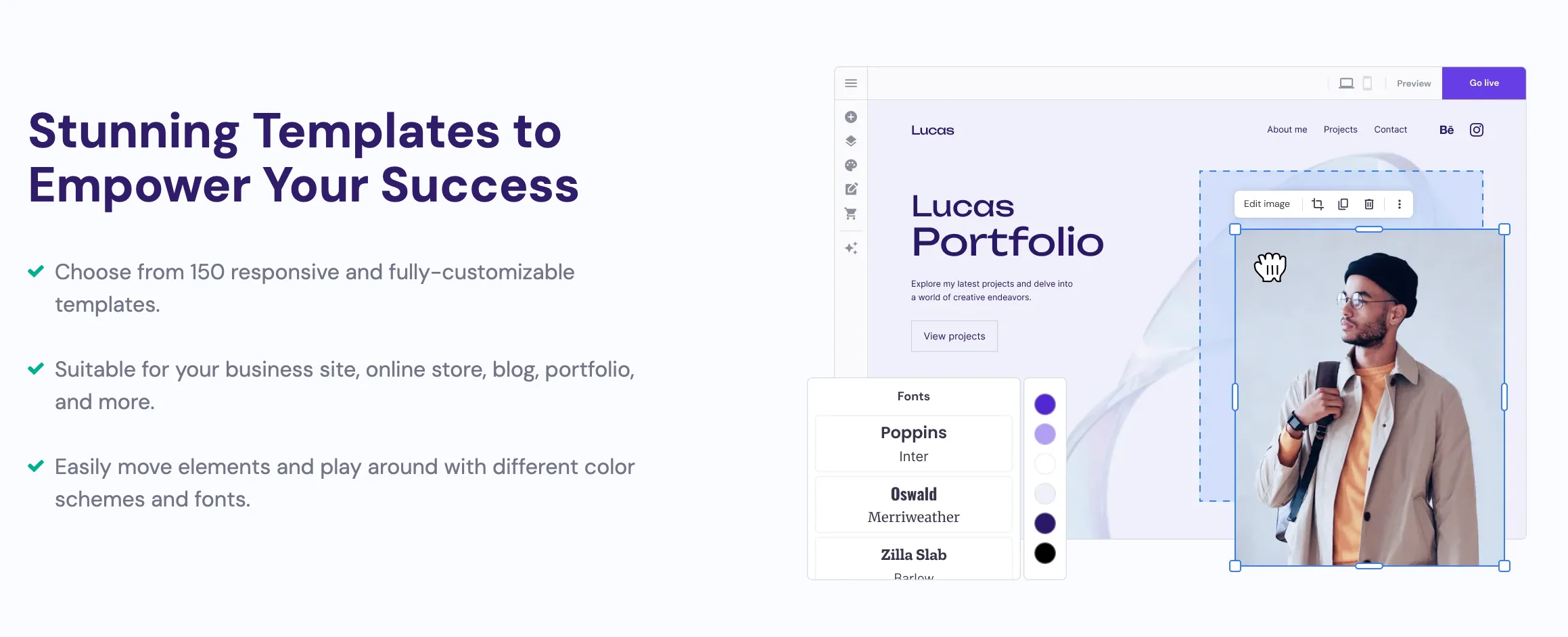
There are thousands of free and paid themes out there already, and the WordPress community is always creating more.
When picking a theme for blogs, we recommend StudioPress. The themes are a bit more expensive at $130. (Most themes go for $20–50.) But it’s totally worth it. StudioPress was purchased by WP Engine and WP Engine now includes all the StudioPress themes as part of its hosting package. It’s a nice freebie if you are already planning on hosting your site with WP Engine.
If you want a wider selection of WordPress themes at standard prices, Themeforest is the most popular WordPress theme marketplace.
Still not sure? Check out our top list of the best WordPress themes for blogs. You’ll probably find something there that is perfect to start out with.
ACTION STEP: Purchase a theme and add it to your website.
After you purchase your theme, log into your WordPress blog, go to the Theme section which is under Appearance in the WordPress sidebar menu. Then follow the instructions for adding the theme.
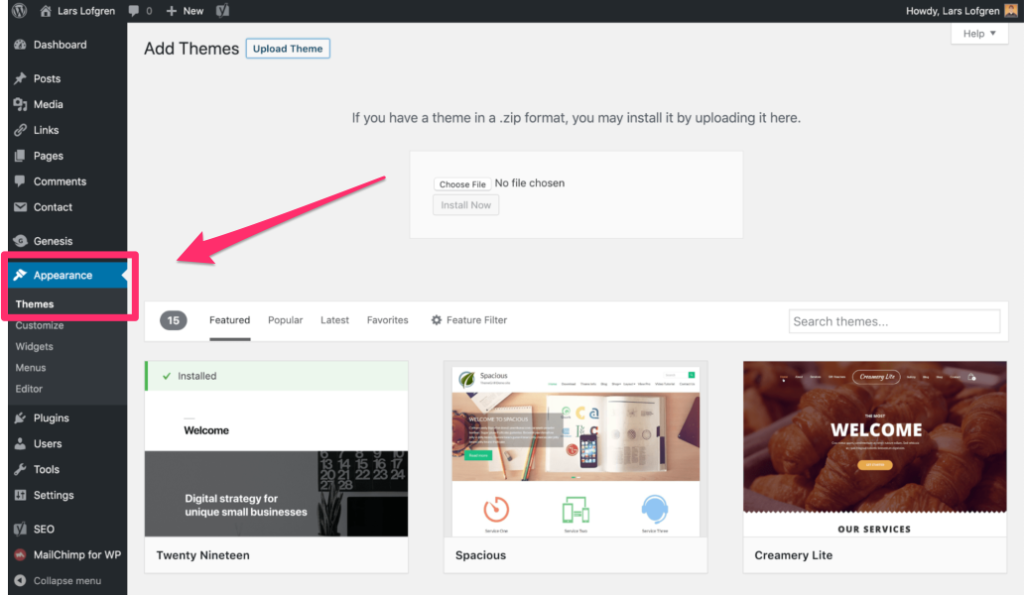
You’ll have to upload the theme files to WordPress and activate the theme from within WordPress. You can find the upload option by going to Themes > Add New, a button towards the top. Then you’ll see this option to upload:

You’ll be able to manage any themes you’ve uploaded to your WordPress blog from your Themes section:

You can always use free themes if you don’t want to pay for one, helping to keep your startup costs low. Just be aware that some free themes lack the features and customization options that come with premium themes. Some free themes are poorly coded, which could slow down your site or open you up to security vulnerabilities.
Step 6: Install WordPress Plugins
One of the best parts about WordPress is that it’s infinitely customizable. Since it’s open-source, you can change it to do whatever you want.
The easiest way to make changes is with plugins. Plugins are little batches of software you can install within WordPress to get extra functionality. This is how you’ll add a bunch of extra features to your site without having to code anything yourself.
Be careful here and try not to go overboard.
Some bloggers will install dozens of plugins on their blogs. That can cause a bunch of problems later on.
Not only can plugins cause unexpected conflicts with each other, they become a security liability since it’s unlikely that every plugin owner will maintain the plugin over time. They also become a huge headache to manage.
When you have that many plugins, you’re never sure which plugin is causing a particular problem.
Keep your selection limited to 5–10 amazing plugins at most.
ACTION STEP: Download only helpful plugins.
Here are a few of our favorites:
- Akismet – Required for every blog, it automatically filters a ton of comment spam which is a problem for every blogger.
- Yoast SEO – The most highly recommended SEO plugin, it handles a bunch of SEO tasks automatically for you and also makes on-page SEO tasks a lot easier.
- Contact Form 7 – The most popular contact form out there. Set up a contact page on your site, and then use this plugin to create a contact form that will email you any time someone fills out the form. Super easy.
- TinyMCE Advanced – A bunch of improvements to the WordPress editor that makes writing in WordPress a lot easier. These days, you can usually skip this one. Writing your posts in Google Docs and then formatting them in WordPress using its default HTML editor is just fine.
- WP Super Cache – A good plugin to speed up your site.
- MailChimp for WordPress – More on this below. It’s the easiest way to connect your WordPress site to a MailChimp account, create an email signup form, and start collecting email subscribers.
- WordPress Popular Posts – Easiest way to add a list of your most popular posts to your blog sidebar. The list will update automatically.

Step 7: Install Google Analytics
Google Analytics is a free tool that will help you monitor key performance metrics related to your blog traffic.
You can use it to see how many site visits you’re getting, the demographics of your visitors, and see which pages are driving the most traffic.
With that said, Google Analytics can get tricky if you don’t know how to use it. That’s why we’re going to ignore the majority of what the tool can do—at least for the moment.
Right now, you just need to create a Google Analytics account and install it on your blog.
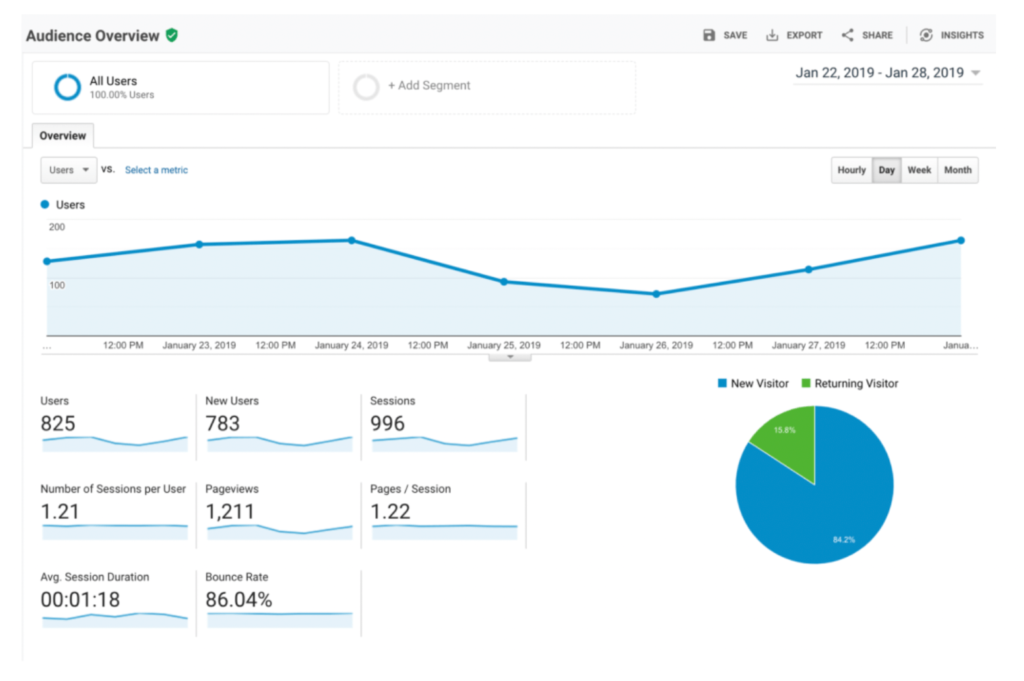
While there are dozens of reasons why Google Analytics should be installed on your site, there are two major ones that we’re going to focus on right now.
First, Google Analytics tracks your data over time. So when you’re ready to dive deeper into the weeds later on, you’ll be happy that you’ve been collecting data from day one.
Second, it’s encouraging to watch people visit your blog in the early stages. This can give you the motivation you need to continue putting in the work required to scale your blog.
Google Analytics is also really easy to set up. Here’s how you do it:
Log into Google Analytics
This is simple. Go to Google Analytics and click on Start Measuring.
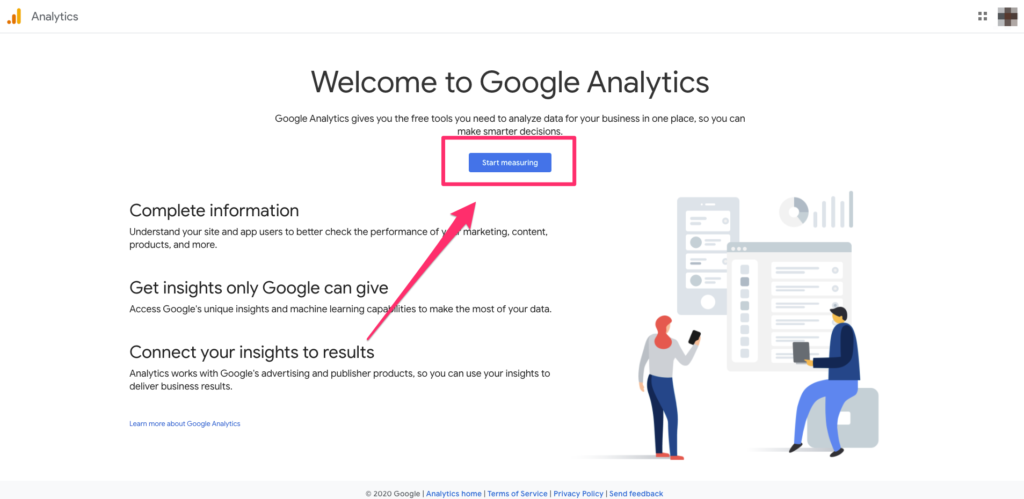
If you’re not logged into a Google account, it’ll ask you to log in to your Google account. If you have one, do so. If not, create one and log in with that.
Create your Google Analytics Account
The tool asks you to provide an account name. Use the name of your website or blog for this.
Don’t worry about the boxes with the checkmarks for now. You can always change them later.
Once you do that, click on Next at the bottom.
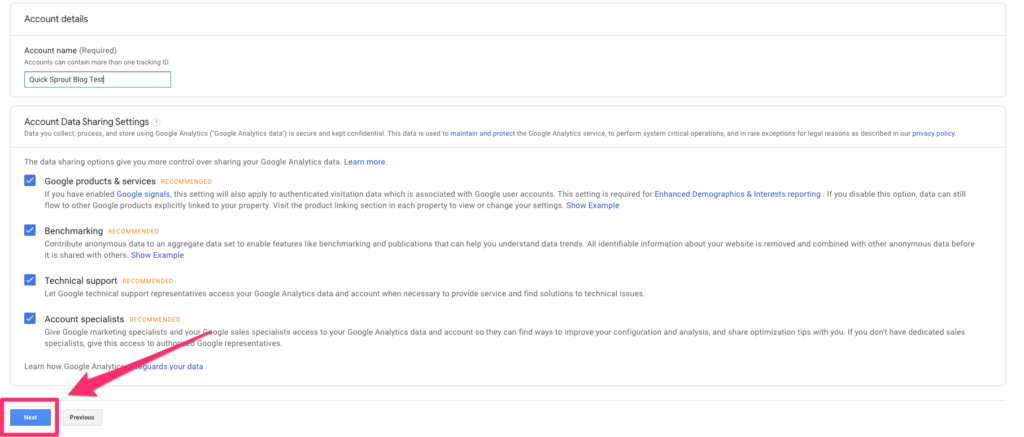
Choose what you want to measure
This screen asks you to choose whether you want to measure a website, an app, or a combination of both.
Choose Web since you’re creating a blog.
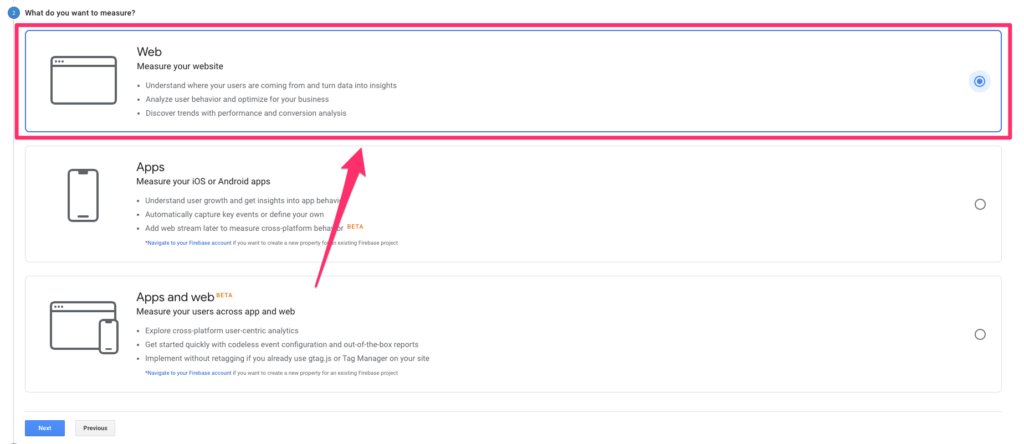
Then click Next.
Fill in the property details
Now fill in some details about your website, including its name, the URL, your industry category, and your timezone.
Once you’ve done that, click on Create at the bottom.

Copy and paste the tracking code onto your site
Once your account is created, you’ll have a unique JavaScript tracking code for your site. When you copy and paste that snippet of code into your site, Google Analytics will start collecting data for you.
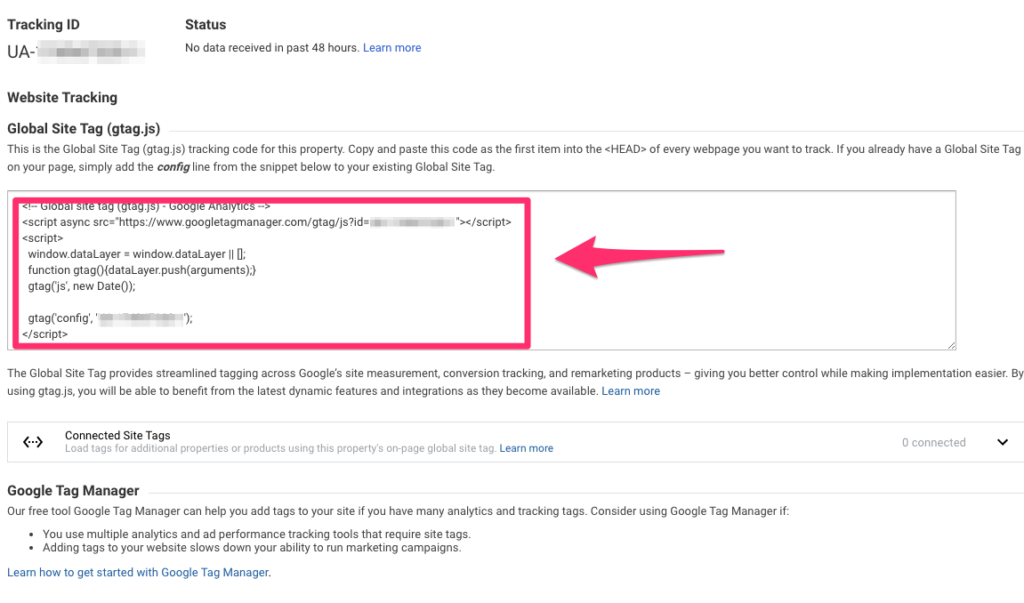
Voila! That’s it. You are now tracking Google Analytics for your website.
If you’re still having trouble or need more instructions, we have an in-depth guide on setting up Google Analytics.
Step 8: Set Up Your Email List
Every marketing engine relies on emails at its core. And there’s a good reason for that: Email lists are the best marketing tool. Period.
Think of your email list as a giant laser ray; you can focus on any offer you want.
Selling consulting? Pitch your list to the reader. Publishing a new blog post? Pitch your list at the bottom of the blog post. A podcast just interviewed you? Pitch your list to the podcast’s audience.
Of all the marketing channels that have come and gone over the years, nothing compares to the power of a high-quality email list.
Even if you’re not sure what to send your email subscribers, that’s okay. The important thing is you start gathering a list of subscribers and build the foundation early.
ACTION STEP: Create an email list.
Using Constant Contact or other email marketing services, start collecting emails on your blog so that the list is ready for you as soon as you need it. It takes time to build a decent size list so your future self will be extremely grateful if you set it up now.
Even a super basic opt-in in your blog sidebar is enough to get you started, like this one from Divalicious Recipes.
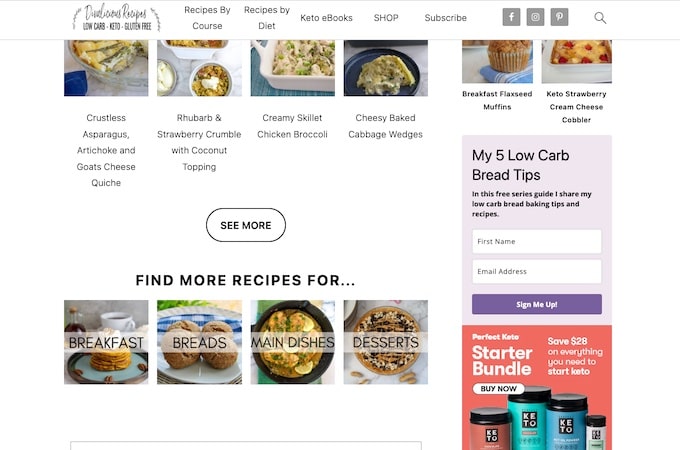
Don’t even worry about sending any emails yet unless you want to. The main thing is that you’re collecting email subscribers from the beginning. Email lists can be a gold mine once you have a few thousand subscribers, and the money really rolls in once you have 10,000 subscribers and above.
Step 9: Pick a Blogging Cadence
Writing blog posts isn’t a sprint, it’s a marathon. Actually, it’s more like a multi-day backpacking trip.
The best bloggers settle into a consistent writing pace they can maintain for a few years. That’s right, years.
Here are a few posting frequency rules of thumb:
- At the bare minimum, find a way to post once per week. This needs to be a substantial post, too: 2,000 words at least. Long-form content receives twice as many page views, and Google’s algorithms favor content that is 3,000 words or longer. We recommend you start here.
- Serious bloggers will post 2-3 times per week.
- Larger sites quickly get to 5-7 posts per week. This requires multiple authors.
- The heavy hitters who push things to the limit will do 25-50 posts per week. No joke, this is for large businesses using content marketing as their primary customer acquisition channel. HubSpot is a classic example of this.
That said, don’t fall into the trap of writing your blog for search engine optimization (SEO) rather than for your readers. While SEO is important and can help increase your visibility, it shouldn’t come at the cost of creating quality content.
AI-based content creation tools can help to scale up your writing quickly, but you should always make sure to review the output before publication.
For example:
- SEO optimization tools like Clearscope are helpful for showing you keywords to include, but good “content grades” on these tools don’t equate to actual good content.
- AI content generators can help you write blogs faster, but they don’t know your audience, your subject matter, or your personal writing style. They also produce content at all costs, so they occasionally produce content that is completely false.
- Software like Grammarly is great for catching typos, but don’t listen to all of its suggestions—your English teacher isn’t grading your blog and your audience won’t respond to perfect-sounding sentences and robotic grammar.
- Your posts that generate the most traffic won’t always be the ones with the highest volume. If anything, highly targeted posts with fewer, more engaged readers will end up making you the most money.
It will get easier to publish posts the more you do it. Getting several posts out the door each week might sound like a lot now, but over time, every part of your process will get quicker.
The important thing is to start your blogging cadence off on the right foot. Begin with a weekly publishing rhythm, and build from there.
ACTION STEP: Start posting at least once a week.
Writing isn’t easy. It’s a grind for all of us. This is why we recommend starting at one post per week.
That still gives you the majority of the week to focus on other aspects of your site while also giving you a break from writing blog posts all the time.
A really great post should take you two days to complete. The first day is for research and outlining, along with as much writing as you can complete. The second day is for finishing the writing, proofreading, and publishing the post in WordPress.
Also, push quality as hard as you can. The key to building a site and traffic over time is to write posts that are more valuable than what other people have already published in your category.
Step 10: Build an Audience
Start by trying to get 1,000 true fans. With this goal, you can start to fully support yourself.
You can quit your job, work wherever you like, and be in complete control of your life. All from hitting a very reasonable goal of 1,000 dedicated readers.
With blogging, you’ll build your audience of 1,000 true fans slowly and consistently.
As long as you keep at it, you will get there. Typically, it takes a few years.
That said, it’s possible. 77% of internet users read blogs, and all you need is a tiny fraction of them to make a substantial living.
ACTION STEP: Use this system to get 1,000 true readers.
Here’s what to focus on in order to get there faster:
- Always post at least once per week. Never skip a week.
- Start posting 2-3 times per week if you can.
- On every post, push on quality as hard as you can. Google the topic and see what other people have done, then ask yourself how you can write something even better.
- Write stuff that hasn’t been written to death already. Find a new take or perspective on your topics that other people haven’t already covered.
- Find your voice and be authentic so people can get to know you. This builds connections with your audience faster. A quick hack for this is to pretend that you’re writing your posts to a close friend.
- Allow your readers to comment. Disqus has a ton of users and allows readers to leave feedback, praise your post, or leave criticism for it. If you’re up to engaging your first core readers, leverage this to make a solid connection with them.
- To push even harder, get active in other online communities. Post in Facebook groups, subreddits, on Twitter, do podcast interviews, get speaking engagements when you can – anything and everything. Be as helpful as you can be in these communities.
- For all of your content, constantly ask yourself, “How can I make this as valuable as possible?
As your blog audience matures, you will want to change your traffic strategies as you grow.
Step 11: Monetize Your Blog
There are three ways blogs make money.
Yes, only three. They are:
- Infoproducts. Online courses, webinars, e-books, etc.
- Affiliate programs. You work with a brand to promote their products and you get a cut of any sales.
- Freelancing and consulting. You use your blog as a platform to find clients and customers for your own services.
Here’s a quick primer on how they work:
How info products work
We could write a book on info products. For now, we’ll keep it simple. Here’s the model:
- Get people to visit your site.
- Then, give them a reason to subscribe to your email list.
- Once they’re an email subscriber, run them through a launch funnel. These are email funnels specifically designed to sell info products. Usually, these are courses that include a bunch of video lessons.
- Depending on your volume and target market, you’ll convert about 0.5% to 1% of new email subscribers into a customer for $500-$2,000 for your course. At volume, that adds up fast.
Now, this sounds too good to be true. While there are a few catches, it’s mostly true. What are the catches?
First, you’ll need to get extremely good at direct-response copy.
Second, it helps to be in the right category. People want money, status, and relationships.
How affiliate programs work
Affiliate marketing is pretty simple: You go about creating as large of an audience as possible. Then, throughout your content, you recommend products that are helpful to that audience.
When your audience clicks through the link of that recommendation, they get a special tracking code. If they end up purchasing, you get a cut of the sale.
You have no doubt seen affiliate disclosures on websites for years, like this one for Outside Magazine’s online edition.
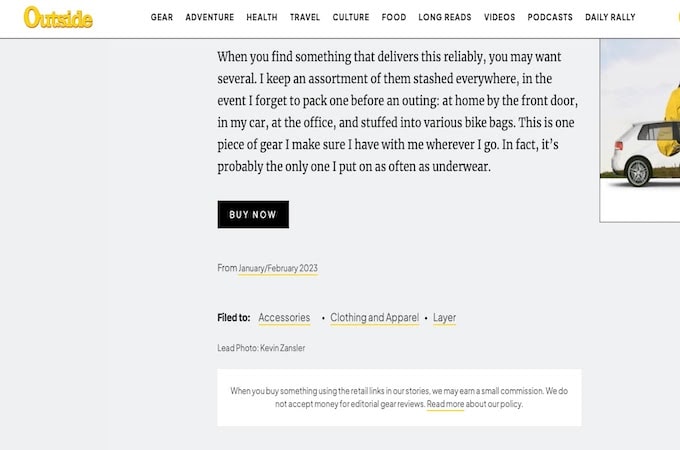
The main downside is that only a small percentage of people will ever click through and an even smaller percentage of people will purchase. So it really helps to have a massive amount of traffic in order to make enough money from your blog.
It’s safe to say that Outside magazine has a big enough following to make affiliate links profitable for them.
How freelancing and consulting works
While info products and affiliates are the main ways to make serious money, you also need serious traffic in order to make them work. At least if you want them to work well enough to make six figures per year.
That’s why freelancing and consulting are the best ways for beginners to start making money fast while blogging.
To make money quickly, this is by far your best option. It’s also the easiest to do.
Freelancing programs have taught thousands of people how to get started freelancing. What always blew me away was how life-changing those first few freelancing gigs are.
Anyone can create a blog and use it for freelancing lead generation. It’s enough to build a client base that pays you $3,000 to $5,000 per month. That’s enough to quit your job. That’s life-changing.
And it’s a much easier goal to hit than a fully ramped-up affiliate or info product marketing machine. You always have the option to build that stuff later anyway.
What about all those other monetization methods?
Most of them are a waste of time. The impact on revenue is marginal, it’s a complete distraction. A few are worth doing for marketing and branding. The rest should be ignored entirely. Here’s the list that bloggers always try at some point:
- Books – Great for marketing. Adds a ton of credibility to your brand. But you likely won’t feel the impact on revenue at all when it comes to royalities. However, they are great marketing and lead generation tools.
- Events – All the risk is front-loaded, all contracts get locked up ahead of time, they’re a pain to sell, and you don’t even know if you’ll make any money until right before the event. Even if you do make money, the margins are terrible. These are complete distractions and a huge opportunity cost for the business.
- Banner ads (Google Ads, formerlly Adsense, for example) – The last time these made any decent money was around 2003. These days, we’re not even sure it’s possible to get banner ads to cover your hosting bill.
- Speaking – Done the right way, occasional speaking can be a great brand builder. And while it sounds amazing to get paid $20,000 per speaking gig, it’s not nearly as amazing once you learn most speakers never get paid, it takes months worth of work to create a talk that commands that kind of fee, you really need a New York Times Bestseller in order to charge real fees, and you’ll get so sick of hotel rooms after the first year that you’ll never want to travel again. Do speaking gigs when good opportunities come up; don’t build a business on them.
Don’t let this discourage you though. The important thing is that you get started building your blog and writing. Do it consistently and stick to the system, and you’ll find that success comes quicker than you think.
That brings us to our last action step…
LAST ACTION STEP: Keep Growing! Read articles on how to start and grow a successful blog.
